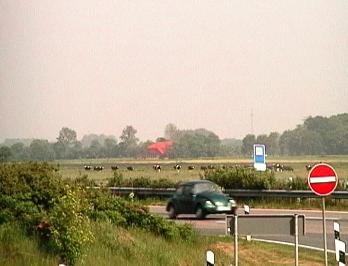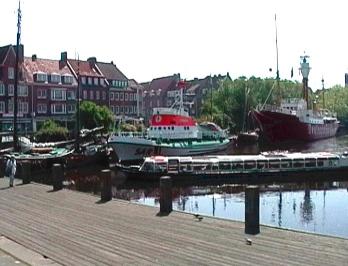Emden Factory Visit
May 27th, 1999
Copyright © 1999, 2000 Bernd Felsche, Perth, Western Australia
All Rights Reserved
This Document may not be copied without the author's written permission.
Factory Images Copyright © Volkswagen. Source:
http://besucherdienst.volkswagen.de
Getting there is Half the Fun
After an early start from Herne, a small Ruhr city just west of
Dortmund, at 6:30 a.m. to make it to the factory on time for a 9:30
tour and to find that morning tours are for groups. There's only the
one of me so I had a whole morning to explore the nearby city of
Emden.
It must be a Thursday: I could never get the hang of Thursdays.
|
Still, the early morning run wasn't a waste. By heading out of the
most-congested traffic region in Germany before the rush hours, I saved
loads of time and fuel while enjoying the drive at the same time.
Although I was on a tight schedule, I had time to explore one of
Germany's ultimate back-roads; the A31 Autobahn.
Hang on, you say... an Autobahn isn't a back road!
This one is ... it has a 10km gap near one end which means that you
have to navigate through some small towns to bridge that gap. The A31
would otherwise be a well-used artery between the Rhine-Ruhr region and
Emden, as well as providing an alternate route to the heavily-policed
Dutch roads a few km to the West.
|

Beetle at speed on the A31 |
Now, if you're prepared to bridge the gap near Lingen, you will be
rewarded by an nearly-deserted stretch of Autobahn for most of the
200km to Emden. An excellent opportunity to stretch your car to its
limits and to blow away the cobwebs. It's not an invitation to be
reckless; your life is at risk if you do something stupid.
The weather was fine and dry, even getting a little warm in the
non-aircon Golf GTI 16V. No reason to rush but it's always nice to
put some spare time up your sleeve if the chance crops up.
So I "stretch" the 16V to 150 kmh with occasional spurts to 180 kmh
where there's a clear run (i.e. most of the way).
It's tempting to just go flat out all the way, but sanity must be
kept as you're moving at between 2½ and 3 kilometres every
minute, that's up to a thousand metres every 20 seconds.
Or about 170 metres for your average 3-second lapse of concentration.
Nearing Emden, you'll pass near the test circuit of the German
Transrapid train, a very-high-speed but controversial mode of transport
intended to connect major cities; initially Hamburg and Berlin. A
useful diversion if you find the A31 altogether too boring.
Emden
|
Emden
town is a typical East-Friesian community.
It's a port city on the North Sea.
The place is surrounded by canals and as you approach the city via the
A31 from the South, you pass underneath a major canal.
A novel experience to be crossing a canal by going under a ship.
(No scuba gear is required.)
Few hills mean that bicycles are quite a popular and practical mode of
transport.
The harbour which stretches into the centre of town is interesting.
If you want, you can go for a leisurely cruise.
Very tourist-y.
Sorry, the links are only in German at the time of writing.
|

Typical Town Hall |

Tourist sightseeing by boat |
Although I was only in town for a few hours but felt a more relaxed
atmosphere than in the "real Germany".
It seems much more open and friendly than the stuffy crowd in the
inland.
They are still conservative, but they don't seem closed off from
other cultures.
Shortly after noon, I leave town and head out to the factory only a few
minutes drive away. It's not excessively signposted so you need to keep
an eye out for the VW logos on faded roadside signs.
|
The Volkswagen Works Tour
Having found a place to put your car in the almost-full carpark, you
report to the gate-house where you are relieved of the burden of any
camera equipment.
How nice.
It's not that they want to keep secrets; it's for safety reasons as
previous visitors have previously upset robots and other automation
equipment with the flash from their cameras.
Also, the workers prefer not to be photographed while working. It's bad
enough being watched as if you were in a zoo.
Volkswagen's Visitors' Service provides online information about
the Emden works.
I would suggest that you contact the Emden Works' Visitors' Service
to confirm that a tour will be available in your preferred language
before you make the long trip.
The visitors' reception area features a large model of the plant
layout, showing roads, docks, and railways as well as factory buildings
- but no details of the new test circuit used for quality control
within the works' perimeter.
The high ceiling and tall windows make the area an airy,
welcoming place.
|

Location map from the Visitors' Service Site
|
Another feature of the reception area is the last Beetle produced in
Germany. A white "plain-Jane" base model with painted bumpers, no glove
compartment lid and powered by a 1200cc, 25kW/34bhp engine.

Aerial View
|
The tour begins with a briefing around the model with a few facts
thrown in to impress those who already aren't.
Following that, each visitor is given a headset and radio receiver for
the tour guide's commentary.
You then set off per pedes for about an hour and a half of
casual walking with frequent stops.
So you only cover a small portion of the overall area, but in some
detail as you are not whisked past places of interest in a carriage.
|
The plant owes its existence to the Beetle which was produced there
from December 12th, 1964 until the 19th of January, 1978; mainly for
export to North American and Japanese markets.
A total of 2,360,591 Beetles were made in Emden.
The factory has had mixed fortunes over the past two decades.
Its current 10.900 employees, of which about 9000 are permanent, produce
around 1250 Passat cars a day.
Another 600 Passats are produced daily at the Mosel works near Zwickau.
Although direct employment by Volkswagen in Emden is relatively small,
50% of East Friesland's economy depends on the operation.
Just about all parts arrive by rail, including for the time being,
body pressings which are shipped from Kassel.
Just-in-time (JIT) supplies are critical for 90% of the production.
Bumpers are made to order by a supplier in Oldenburg (some 130km to
the East) and delivered within 6 hours.
324 KUKA robots (from near Augsburg, Germany) share the production on
two lines for sedan and variant.
Some 5500 welds are made on every car.
Volkswagen gave up building its own robots a decade or so ago when
the off-the-shelf models made more sense than their custom units.
The plant works in 3 shifts in 3 halls around the clock.
Robot maintenance is by in-house staff, trained by KUKA.
Welding machines are fixed on the floor and robots manipulate the
assembly, twisting and angling the workpiece until it is in exactly the
right place and orientation for the spot-weld to take place.
The same robot moves the workpiece from one welding station to the next
within its fenced-off corral.
This is the opposite of that traditionally used in many other places
where the workpiece remains fixed on the conveyor system and the
welding heads are moved to the required positions.
Some welds are still done by hand where the required weld is too
complicated to reach.
Epoxy resin is applied prior to some spot welds to increase overall
rigidity.
The final "floorpan" is unified from 5 main subassemblies.
Watching a robot arm twirl 100kg+ assemblies (the tour-guide
was unable to confirm my estimate of the mass) around from one welding
station to the next in a matter of a second or three, is more
impressive to watch than a circus juggler battling Bruce Lee.
Various spot, CO2 and LASER welds go into making the Passat.
Barcodes are applied on the floorpan to identify each one as different
stiffening being required for different models.
Welds are checked for integrity along the line using hammer and chisel.
One in 30 welds is checked.
The most high-tech LASER welding is used to join the side and roof of
the car, where the quality is most apparent and also most desirable
from a strength point of view.
Welding in each of the two special booths (one for each line) takes
some 15 seconds for the 2kW LASER dose per car.
The total cycle time is 52 seconds.
Templates are then used to verify the dimensions of openings.
Emden is proud of its paint shop, the control for which is some 32m
above the floor under a roof height of 54m.
There are a total of 109.5km of conveyors within.
Engine and drivetrain are delivered from various plants around Germany
and assembled by workgroups.
Half the engines used are TDI, 30% of them using the new pump-injector
technology.
The 125 bhp unit was most common petrol engine at the time of the visit.
Marriage of drivetrain into body is by hand on conveyors, and takes
just 90 seconds per car.
That would make you think that there is still much work being done
in this age of robots and automation.
Specifically; 3500 people are needed to run both lines at Emden.
Special work platforms are provided for easy access to the vehicle
which not only makes the job easier and safer, but also more productive.
Another example of the irreplacable human is where the preassembled
dashboard weighing around 70 kg is steered into each vehicle. by one
worker, then fastened by 3 screws.
Airconditioning is fitted to between 90 and 95% of all Passats in
Germany.
Just one of over 100,000 cockpit combinations which the factory
assembles.
Ever wondered about those funky bends in brake and fuel lines?
There are programmable pipe bend robots which make up to 8 million
lines per year.
Plenty for in-house requirements and spares.

Factory Floor
|
When the Passat rolls off the line destined for the docks or rail/road
loading bay, it's made up of anywhere between 8500 and 12,000 parts
assembled at the factory.
That's well over a million parts a day when
you multiply it by the 1250 vehicles a day.
An impressive juggling act.
|
The Journey Continues
The tour finishes about 4 p.m..
That leaves plenty of time to dash down the A31 to Geeste,
the next point on my itinerary for a Käfer-Treffen - a meeting
of old Beetles.
Touring Tip
Stock up on drinks and some nibbles at the supermarkets found on the
outskirts of town.
I bought, amongst other things, a six-pack of Apfel-Schorle
a mix of lemonade (or sparkling mineral water) and apple juice which
is not just suprisingly refreshing, but also helps to keep you alert.
|

A short break on the A31 to stretch
and have a drink while counting the windmills. |
Email:
bernie@innovative.iinet.net.au
Copyright © 1999, 2000 Bernd Felsche.
Factory Images Copyright © Volkswagen. Source:
http://besucherdienst.volkswagen.de






